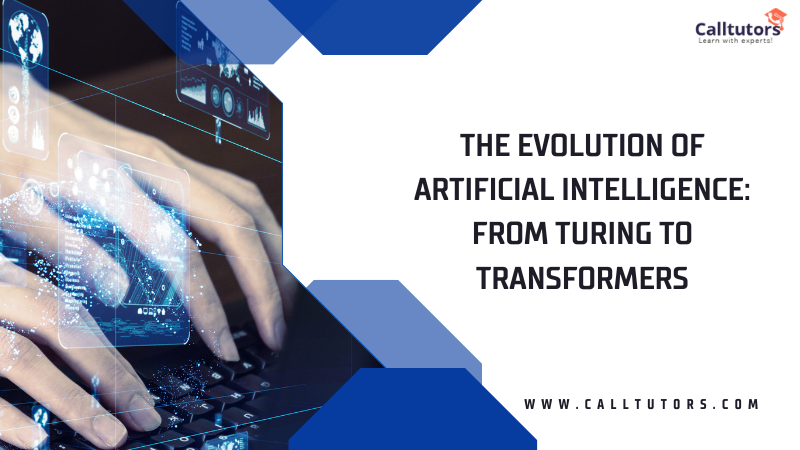Artificial Intelligence (AI) has come a long way since its inception, evolving from theoretical concepts to practical applications that permeate various aspects of our lives. The journey of AI began with the visionary ideas of Alan Turing and has progressed exponentially, with modern innovations like Transformers revolutionizing the field. In this blog, we will explore the key milestones in the evolution of AI, from Turing’s foundational work to the transformative impact of Transformers.
Note: Looking for computer science assignment help experts? Then hire our reliable experts who can help you with any type of computer science assignment. Order now!
1. Alan Turing and the Birth of AI
The concept of AI traces back to the mid-20th century when Alan Turing, a British mathematician and logician, posed the question, “Can machines think?” in his influential paper titled “Computing Machinery and Intelligence” (1950). Turing proposed the Turing Test, a method to determine whether a machine possesses human-like intelligence. This groundbreaking idea laid the foundation for the field of AI and sparked decades of research and experimentation.
2. The AI Winter: Disillusionment and Resurgence
After Turing’s groundbreaking work, early AI research experienced significant enthusiasm, but the progress didn’t meet initial expectations. The 1970s and 1980s witnessed a period known as the “AI winter” when funding and interest in AI dwindled due to the inability of AI systems to deliver on their promises. However, in the late 1990s, AI experienced a resurgence with advancements in machine learning, data availability, and computational power.
3. Machine Learning and Neural Networks
Machine learning, a subfield of AI, emerged as a key driving force in AI’s evolution. Researchers began to explore algorithms that allowed computers to learn from data and improve their performance over time. Neural networks, inspired by the structure of the human brain, gained popularity for their ability to recognize patterns and solve complex problems. The development of backpropagation in the 1980s enabled efficient training of neural networks.
4. Deep Learning and the AI Revolution
The breakthroughs in machine learning, particularly deep learning, marked the beginning of the AI revolution. Deep learning algorithms, fueled by vast amounts of data and powerful GPUs, achieved remarkable results in tasks such as image and speech recognition, natural language processing, and game playing. Companies started integrating AI into various products and services, transforming industries like healthcare, finance, and transportation.
5. The Rise of Robotics and Autonomous Systems
Advancements in AI led to the rise of robotics and autonomous systems. From self-driving cars to robotic surgery, AI-powered machines demonstrated their potential to enhance efficiency and safety across diverse sectors. These innovations opened up new possibilities for AI applications, driving further research and development.
6. Reinforcement Learning and AlphaGo’s Triumph
Reinforcement learning, a form of machine learning where agents learn by interacting with their environment, played a pivotal role in achieving significant milestones. One notable example was Google’s AlphaGo, which defeated the world champion in the ancient Chinese board game, Go. AlphaGo’s success showcased the power of deep reinforcement learning and its ability to conquer complex strategic games.
7. Transformers: The Language Processing Revolution
Transformers, introduced in the paper “Attention is All You Need” by Vaswani et al. in 2017, revolutionized natural language processing (NLP). This architecture relies on self-attention mechanisms to process sequences of data, making it exceptionally powerful in tasks like machine translation, text generation, and sentiment analysis. Transformers paved the way for advancements in NLP, leading to the development of cutting-edge language models like BERT and GPT-3.
8. Ethical Considerations and Responsible AI
As AI capabilities expanded, so did concerns about its ethical implications. Issues surrounding bias in AI algorithms, privacy concerns, and the potential impact of automation on jobs and society came to the forefront. Researchers, policymakers, and industry leaders began emphasizing the importance of developing AI responsibly and ethically.
9. AI in Everyday Life
Today, AI is deeply integrated into our daily lives. Virtual assistants like Siri and Alexa help us with tasks, recommendation systems suggest products and content tailored to our preferences, and AI-powered algorithms shape our social media feeds. AI’s influence continues to grow as technology becomes more pervasive and interconnected.
10. The Future of AI
The journey of AI is far from over. As technology advances, AI will continue to evolve, with potential applications in areas such as personalized medicine, climate modeling, and space exploration. Research in AI safety and explainability will play a crucial role in building trust in AI systems and ensuring their responsible deployment.
If you want to know more about this topic you can visit calltutors.com
Conclusion
The evolution of AI from Turing’s theoretical concepts to the transformative power of Transformers has been a remarkable journey. Over the decades, AI has grown from a mere idea to a force that shapes our daily lives and drives innovation across industries. As we move forward, embracing AI’s potential while addressing its ethical and societal challenges will be key to realizing a future where AI benefits humanity in unprecedented ways. The quest for artificial general intelligence continues, and the possibilities seem limitless.


